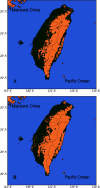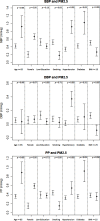Long-Term Exposure to Fine Particulate Matter, Blood Pressure, and Incident Hypertension in Taiwanese Adults
- PMID: 29351544
- PMCID: PMC6014706
- DOI: 10.1289/EHP2466
Long-Term Exposure to Fine Particulate Matter, Blood Pressure, and Incident Hypertension in Taiwanese Adults
Abstract
Background: Long-term exposure to particulate matter (PM) air pollution may increase blood pressure and the risk of hypertension. However, epidemiological evidence is scarce and inconsistent.
Objectives: We investigated the associations between long-term exposure to PM with an aerodynamic diameter <2.5μm (PM2.5), blood pressure, and incident hypertension in a large Taiwanese cohort.
Methods: We studied 361,560 adults ≥18y old from a large cohort who participated in a standard medical examination program during 2001 to 2014. Among this group, 125,913 nonhypertensive participants were followed up. A satellite-based spatiotemporal model was used to estimate the 2-y average PM2.5 concentrations at each participant's address. Multivariable linear regression was used in the cross-sectional data analysis with the 361,560 participants to investigate the associations between PM2.5 and systolic blood pressure (SBP), diastolic blood pressure (DBP), and pulse pressure (PP), and Cox proportional hazard regression was used in the cohort data analysis with the 125,913 participants to investigate the associations between PM2.5 and incident hypertension.
Results: Each 10-μg/m3 increment in the 2-y average PM2.5 concentration was associated with increases of 0.45 mmHg [95% confidence interval (CI): 0.40, 0.50], 0.07 mmHg (95% CI: 0.04, 0.11), and 0.38 mmHg (95% CI: 0.33, 0.42) in SBP, DBP, and PP, respectively, after adjusting for a wide range of covariates and possible confounders. Each 10-μg/m3 increment in the 2-y average PM2.5 concentration was associated with an increase of 3% in the risk of developing hypertension [hazard ratio=1.03 (95% CI: 1.01, 1.05)]. Stratified and sensitivity analyses yielded similar results.
Conclusions: Long-term exposure to PM2.5 air pollution is associated with higher blood pressure and an increased risk of hypertension. These findings reinforce the importance of air pollution mitigation strategies to reduce the risk of cardiovascular disease. https://doi.org/10.1289/EHP2466.
Figures



References
-
- Bondjers G, Glukhova M, Hansson GK, Postnov YV, Reidy MA, Schwartz SM. 1991. Hypertension and atherosclerosis. Cause and effect, or two effects with one unknown cause? Circulation 84(6suppl):VI2–V16, PMID: 1959216. - PubMed
-
- Brook RD, Rajagopalan S, Pope CA 3rd, Brook JR, Bhatnagar A, Diez-Roux AV, et al. 2010. Particulate matter air pollution and cardiovascular disease: an update to the scientific statement from the American Heart Association. Circulation 121(21):2331–2378, PMID: 20458016, 10.1161/CIR.0b013e3181dbece1. - DOI - PubMed
-
- Brook RD, Urch B, Dvonch JT, Bard RL, Speck M, Keeler G, et al. 2009. Insights into the mechanisms and mediators of the effects of air pollution exposure on blood pressure and vascular function in healthy humans. Hypertension 54(3):659–667, PMID: 19620518, 10.1161/HYPERTENSIONAHA.109.130237. - DOI - PMC - PubMed
Publication types
MeSH terms
Substances
LinkOut - more resources
Full Text Sources
Other Literature Sources
Medical
Miscellaneous

